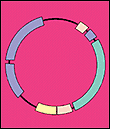|
 Previous Event | Next Event Previous Event | Next Event 
1972: First Recombinant DNA
 The first production of recombinant DNA molecules, using restriction enzymes, occurred in the early 1970s. The first production of recombinant DNA molecules, using restriction enzymes, occurred in the early 1970s.
Recombinant DNA technology involves the joining of DNA from different species and subsequently inserting the hybrid DNA into a host cell, often a bacterium. Researchers at UC San Francisco and Stanford used restriction enzymes to cut DNA from different species at specific sites, and then fused the cut strands from the different species back together. Stanley Cohen of Stanford and Herbert Boyer of UCSF applied for a patent on recombinant DNA technology in 1974; it was granted in 1980. Boyer would co-found Genentech, Inc. in 1976.
The Cohen-Boyer patents eventually had more than 200 licensees – biotechnology and pharmaceutical companies – and earned Stanford and UCSF more than $100 million in royalties.
Paul Berg, a biochemist at Stanford who was among the first to produce a recombinant DNA molecule in 1972, wrote a letter shortly afterwards, along with ten other researchers, to the journal Science. In the letter, they urged the National Institutes of Health to regulate the use of recombinant DNA technology and meanwhile, they urged scientists to halt most recombinant DNA experiments until they better understood whether the technique is safe. These concerns eventually led to the 1975 Asilomar Conference, where one hundred scientists gathered to discuss the safety of manipulating DNA from different species. The meeting resulted in a set of NIH guidelines. NIH has revised the document, "Guidelines for Research Involving Recombinant DNA Molecules," several times since 1976.
More Information
Paul Berg was awarded a Nobel Prize in Chemistry in 1980 "for his fundamental studies of the biochemistry of nucleic acids, with particular regard to recombinant-DNA".
References:
Jackson D.A., Symons R.H., Berg P. Biochemical method for inserting new genetic information into DNA of Simian Virus 40: circular SV40 DNA molecules containing lambda phage genes and the galactose operon of Escherichia coli. Proc Natl Acad Sci, 69(10): 2904-9 1972. [PubMed]
Cohen S.N., Chang A.C., Boyer H.W., Helling R.B. Construction of biologically functional bacterial plasmids in vitro. Proc Natl Acad Sci, 70(11):3240-4. 1973. [PubMed]
Berg P., Baltimore D., Boyer H.W., Cohen S.N., Davis R.W., Hogness D.S., Nathans D., Roblin R., Watson J.D., Weissman S., Zinder N.D. Letter: Potential biohazards of recombinant DNA molecules. Science, 185(148):303. 1974. [PubMed]
 Previous Event | Next Event Previous Event | Next Event 
Last Reviewed: April 17, 2008
|

